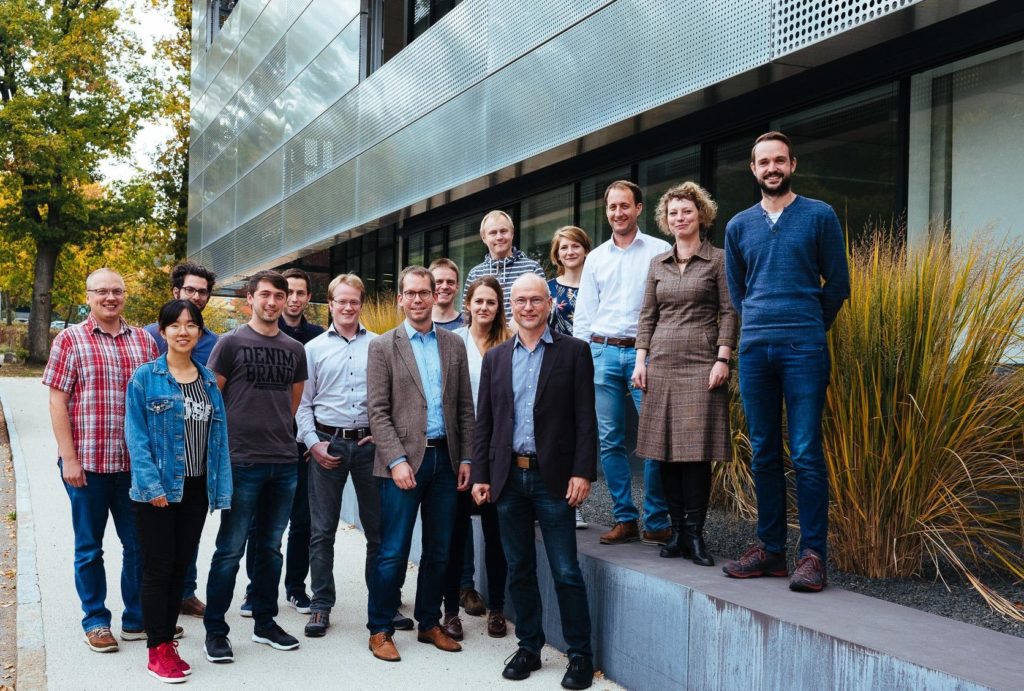(images will be uploaded shortly)
Li-Ion Batteries
Standard lithium ion batteries rely on intercalation electrodes, where lithium ions are inserted in a host structure. In this area, the group of electrochemical multiphysics modelling is concentrating its efforts on lithium intercalation batteries and lithium plating.
Lithium Ion Batteries
Lithium ion batteries are already in wide use in consumer electronics and automotive applications. Nonetheless there are still areas suitable for optimization and further investigations.
Lithium Ion battery usually consist of two porous electrodes, a porous separator and a current collectors for each electrode. The void space inside of the porous media is filled with an electrolyte, consisting of the conducting salt and solvents. The lithium ions are stored inside of the electrodes, which is the reason why this type of battery is also called lithium insertion battery or lithium intercalation battery. A sketch of a typical lithium ion battery is shown in figure 1.
In our group we develop a 3D continuum model for lithium ion batteries [1–3] further to include degradation mechanisms like lithium plating and the growth of the solid electrolyte interphase. The model is implemented into the software BEST (link to BEST in Method section) [4] and allows for simulation of various battery geometries together during charge and discharge. It is also possible to simulate electrochemical impedance spectra. In Fig. 2 the current state of a graphite electrode is exemplary shown.
Lithium Plating
One of the major degradation mechanisms in lithium ion batteries is the so called lithium plating, during this lithium starts to accumulate as metallic lithium on the surface of the active particles. This mostly happens on the negative electrode (Anode). During operation of batteries at low temperatures (<0 °C) and charging with very high currents, the lithium plating is heavily increased.
If this metallic lithium keeps growing and reaches the other electrode, a short circuit is created, which then can lead to thermal runaway and battery failure. Also the growth of the solid electrolyte-interphase (SEI) seems to be enhanced.
In our group detailed models, which consider the effects of microstructure and the electrochemical situation at the surfaces of the active materials, are developed to describe and predict the effect of lithium deposition.
Post-Li Batteries
Conversion reactions save electrode weight and volume and convert more chemical energy by working without a host structure. In this area, the group of electrochemical multiphysics modelling is concentrating its efforts on metal-air as well as metal-sulfur batteries.
Metal-air batteries: Lithium-air, zinc-air, silicon-air, …
Metal-air batteries are one of the most exciting candidates for novel energy storage solutions. On the anode side, they make use of highly pact and highly energetic metals, e.g., lithium, sodium, silicon, magnesium; on the cathode side, they make use of the presence of oxygen in air and its huge binding energy with alkaline atoms.
Lithium ions are the prominent charge carrier in today’s batteries. Therefore, lithium-air batteries remain to be in the focus of research. Choosing the right electrolyte is crucial for their development. We contribute to research on lithium-air batteries with aqueous as well as non-aqueous electrolytes on the pore level and the cell level.
In aqueous alkaline electrolytes, lithium ions react with oxygen to form lithium hydroxide. This reaction takes place in a gas diffusion electrode (GDE), where liquid and gas coexist in a porous structure. We developed, parameterized, and validated the electrochemical dynamics within a GDE including the effects of pressure-driven convection and multi-phase coexistence [1,2]. Pressure-driven convection constitutes a step towards consistent transport theories of electrolyte. The microscopic energetic origins of multi-phase coexistence are further explored with Lattice-Boltzmann theory. Lithium hydroxide concentration in alkaline lithium-air batteries is accumulating during discharge until it precipitates. We found out that this precipitation is inhomogeneous due to the intrinsic properties of alkaline electrolytes [1]. Designing battery cells accordingly is necessary to avoid premature cell death. On a microscopic level, we studied the elementary kinetics of the oxygen reduction reaction on the active surfaces [3].
A second line of our research is devoted to aprotic solvents in lithium-air batteries. On a cell level, we found that slow oxygen transport in flooded electrodes is a limiting factor for power density [4]. On a pore level, we studied the nucleation of lithium peroxide on the active surfaces of the cathode [5]. The discharge product lithium peroxide is found in different morphologies inside lithium air batteries: either it forms films that passivate the active surface, or it forms particles that grow into the electrolyte pore space. In an international collaboration we rationalized that nucleation of lithium peroxide particles happens at discharge currents densities below the exchange current density of the oxygen reduction reaction.
Furthermore, we are performing research on alternative metal-air batteries based upon zinc- or silicon-ions [6]. In analogy to lithium-air batteries, we model spatially inhomogeneous conversion reactions, limiting processes, and crystallization morphologies. It seems advantageous to make use of novel electrolytes, i.e., ion liquids, here. Therefore, we develop a new and consistent transport theory of room temperature ionic liquids.
Surface dynamics
We study interfacial processes on battery anodes. Their understanding is necessary for improving standard lithium ion batteries as well as for realizing novel battery concepts. Graphite as state-of-the-art anode material can only be used because a stable surface film, the solid electrolyte interphase (SEI), is formed that hinders the direct contact between graphite and electrolyte. We model SEI growth and its impact on cell performance. Our model explicitly takes into account the porous SEI structure and its influence on transport processes in the SEI.
Next-generation battery cathodes, however, require novel battery anodes with improved volumetric and gravimetric energy densities. In this respect, metal anodes are perfect candidates for future battery anodes. We model their deposition and dissolution kinetics and optimize them towards homogeneous reaction processes. Lithium metal, for example, is often deposited in needle-like structures, denoted dendrites. Experiments at the HIU show that these dendrites form droplets during their dissolution. This effect would lead to rapid capacity decay in actual batteries. In our simulation, we explain this phenomenon based upon the surface properties of lithium metal and the mechanical strength of the solid electrolyte interphase.
The Lithium Sulfur Battery
Lithium-sulfur batteries are considered as potential next generation chemistry replacing Li-Ion technology. It is expected that Li/S-cells will be close to market level in foreseeable time. Up to now several challenges obviated a successful commercialization.
Major issues are the complex electrochemical and transport mechanisms of dissolved polysulfides during charge and discharge of the battery as well as related degradation mechanisms.
In our group we develop detailed physical multi-scale transport and reaction models of lithium-sulfur batteries on a continuum scale. The models allow deep insights into the operation of the battery and possible degradation mechanisms.
Reaction and transport in lithium-sulfur batteries
In our group we developed a 1D continuum model for lithium-sulfur batteries including a multi-species transport and a multi-step reaction mechanism. The layout of the model follows the schematic setup shown in Figure 1. The implementation allows the simulation of discharge/charge cycles as well as electrochemical impedance spectra [1]. The model is able to reproduce prominent features of discharge curves and impedance spectra of Li/S-cells. In collaboration with the experimental groups [2] the model was compared to in-situ XRD measurements of the cathode and UV/Vis spectra of dissolved polysulfides. The results agree qualitatively and confirm that the polysulfide concentration is highest right after all sulfur has been dissolved.
Furthermore, the framework is used to evaluate different reaction mechanisms discussed controversially in the literature and can therefore contribute to clarify fundamental issues. Related to this topic we also study the effect of adsorption and desolvation phenomena on the surface of active materials. This important process has been neglected in theoretical articles published in the literature.
In addition to this we are working on a 3D microstructure resolved model for lithium-sulfur batteries to achieve a better understanding of the influence of the cathode structure.
Degradation mechanisms
One of the challenges of current state-of-the-art lithium-sulfur batteries is the relatively fast degradation of cell capacity and a low coulombic efficiency upon cycling. This is related to the so-called ‘polysulfide-shuttle’.
Dissolved polysulfides are able to ‘shuttle’ between cathode and anode. Figure 3 shows a schematic of the suggested mechanism during battery charge. Higher-order polysulfides diffuse from the cathode to the anode. Here, they are again reduced to lower-order polysulfides which are in turn able to diffuse back to the cathode. Moreover, solid lithium sulfides precipitate on the surface of the anode which results in a loss of active material. In our model we developed a reduced kinetic mechanism which qualitatively explains above mentioned effects [3].
Structured electrodes
In order to avoid the effects associated with the high solubility of polysulfides a nano-structuring of electrodes has been proposed in the literature. Hollow carbon spheres or CNTs filled with solid sulfur containing material (S8 or Li2S) have been studied as composite material for lithium sulfur batteries. On the one hand the carbon provides an improved electronic conductivity and on the other hand the sulfur is confined within the structure. We develop detailed models taking into account micro-structural effects which also have a strong impact on the overall performance of the battery.
All-Solid-State Batteries
All-solid-state cells use a solid electrolyte instead of the conventional liquid electrolytes. Solid electrolytes are non-flammable, resistant to heat, and have a large electrochemical window. This makes solid electrolyte batteries promising candidates for safe, next-generation high-voltage cells of electromobile energy storage systems.
All-solid-state cells use a solid electrolyte instead of the conventional liquid electrolytes. Solid electrolytes are non-flammable, resistant to heat, and have a large electrochemical window. This makes solid electrolyte batteries promising candidates for safe, next-generation high-voltage cells of electromobile energy storage systems.
Today’s lithium-ion cells usually consist of two porous electrodes in a liquid electrolyte flow. Between the electrodes, a separator is located. The liquid electrolyte cannot simply be replaced by a solid electrolyte. Possible designs of solid all-solid-state cells are so-called thin-film cells, in which three thin films are sputtered on top of each other, and thick-film cells that consist of composite electrodes and a solid electrolyte (see Figure 1). Depending on the electrode materials used, all-solid-state cells may be intercalation or conversion cells.
One of the major challenges in the development of all-solid-state cells is their low power density. It is caused by high interface resistances between solid electrolyte and electrodes. To improve power density of all-solid-state batteries, in-depth understanding of interface processes is required.
If the electrolyte and electrodes are in contact, charge redistributions occur until a local equilibrium is reached. At the interface between electrodes and electrolyte, space-charge layers are form. Crystalline solid electrolytes are characterized by a crystal lattice structure. Irregularities and defects in the lattice structure influence material properties, such as electrical conductivity and mechanical stability. In particular, they allow for ionic conductivity of solid electrolytes. Contrary to liquid electrolytes, only lithium ions move by defect transport mechanisms in the lattice structure and contribute to charge transport, while the anion partial lattice is fixed [1]. The developing spatial cation distribution is represented schematically in Figure 1.
Work of our group focuses on the systematic further development of a rigorously derived transport model to describe space-charge layer formation in crystalline solid electrolytes at room temperature [2]. Based on this model, we enhance understanding of the processes taking place in all-solid-state cells and in particular at the interfaces between electrodes and solid electrolyte. Process dynamics is simulated numerically in one and two dimensions. The developing equilibrium was solved semi-analytically in the 1D case [2]. Contrary to conventional cells with liquid electrolytes, the space-charge layers are much wider and asymmetric.
Parameter studies and virtual material modifications show that the width of the space-charge layers depends on both material and geometry. In this way, apparent contradictions in [3] and [4] with respect to the interface resistances can be resolved and explained.

 Prof. Dr. Arnulf Latz Electrochemical Multiphysics Modeling
Prof. Dr. Arnulf Latz Electrochemical Multiphysics Modeling